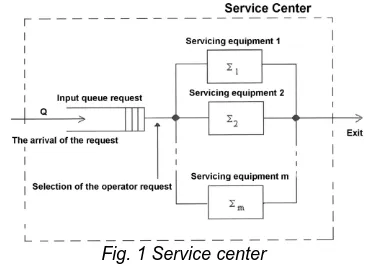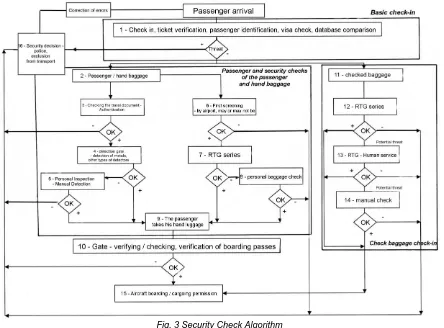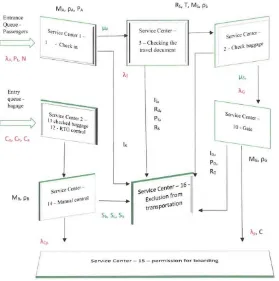Basic Security Model of the Airport
Rudolf Volner, LET´S FLY s.r.o.,
International Airport Ostrava, Mošnov 403, Czech Republic,
rudolf.volner@letsfly.cz
Ľubomír Volner,
Transport Research Institute in Žilina, Slovak Republic,
l.volner@gmail.com
Abstract—This article describes one of the possibilities of modeling security processes in securing airport traffic and trying to minimize the possibility of committing a crime. When designing a physical model, it uses a system of clandestine operation and the possibility of application of evaluation of analytical models to solve the given problem.
Keywords—airport, model, security, SHO
I. INTRODUCTION
Air transport is considered to be the youngest type of transport of people and goods, but during its development it has been tremendously booming and today we can rank it among one of the most advanced types of transport. And today´s world would no longer exist without it.
As air travel is used by a large number of passengers, it is necessary for the airport to be properly prepared for the number of passengers and to provide the necessary comfort. The basics of proper operation and comfort at the airport are a number of aspects that need to be consistent. These include, for example, speed, fluency, quality of technical equipment, personnel, etc., but safety is at the forefront of all.
II. APPLICATION OF ANALYTICAL
MODELS IN SYSTEM MODEL DESIGN
In designing systems may be used in essentially two approaches:
direct measurement and experimentation with the real system,
modeling.
In addition to problems relating to measurement and experimentation with the real system, the fundamental deficiency of this method is that it provides only an analysis of a particular system but no longer a prognosis of the given system under changed conditions.
For these reasons, modeling system evaluation is more commonly used. Real system measurement, however, remains an integral part of system models because it provides important inputs to the model and
also allows for model validation. Based on the model description approach, we divide the models into:
analytical, Simulation.
Reasons for Using Analytical Modeling:
An analytical model can serve as a basis for planning a simulation experiment,
The analytical model, which in this case precedes the simulation, provides a framework estimate of performance variables to define a suitable input parameter interval for which detailed simulation will be applied,
Creating hierarchical models. We describe the system as a whole analytically, part of the evaluated system, which requires a more detailed analysis, simulating.
We can informally define the performance analytical model as a model that describes the behavior of the system using mathematical relationships, and by solving these relationships the desired performance variables are determined.
It is therefore a task to find a set of analytic functions of the type
yi = fi(x1, x2, ...xm; z1, z2, ...zn) (1) where yi - the performance variable,
xj - Configuration parameter of the model system,
zk - Load parameter.
In developing the analytical model, we are going through three main phases:
formulating the model, model solution,
by calibrating and checking the validity of the model.
The basis for the formulation of the analytical model is usually the representation of the original as a Queuing system (SHO).
SHO consists of:
Devices that provide the operator with data flow,
Data stream queues that are waiting for the operator.
may also include a plurality of service devices that serve requests from the same queue, respectively front.
Fig. 1 Service center
Static properties of the service center are defined: number and capacity of queues,
Number of attendance devices.
The dynamic properties of the service center are defined by the description of the transition service - the flow of requirements, i.e.
the characteristics of the process of arriving to the queue,
a characteristic of the process of operating the data streams in the service device,
a queue management strategy that determines the conditions for terminating the data flow handler, choosing the next data stream. SHO with more than one service center is called the queueing network. In the service networks we distinguish whether or not the data flow is exchanged between the network and the environment (so-called open utility network) or not (so-called closed network) – Fig. 2. A network that is open for some types of data streams and for other closed ones is called mixed.
Fig. 2 Service network
The static properties of the serving network are defined:
number and internal characteristics of service centers,
topology of the service network.
The dynamic properties of the serving network are defined:
the process of arriving at the data stream from an external source,
the characteristics of the data flow process in all service centers of the network,
data flow management strategy at the network service centers.
The topology of the service network and the characteristics of the service devices model the static characteristics of the system, that is, the considered configuration. The utility network analytical model simulates a method of processing the load in a system that involves software besides configuration of hardware.
In analytical models, we represent the load in the form of data flows that are required from system resources. From the SHO point of view, it is intervals, respectively. Probability distribution of intervals between the arrivals of data streams requesting the service at a given service center and the operating time; Probability of distribution of the service life of the service center.
According to the method of analytical solution SHO, analytical models can be divided into three groups:
Deterministic models - Middle value models, Extreme models,
probability models:
o models with one service center,
o service networks,
models based on the assumptions of the operational analysis.
III. MODEL DESIGN
The model is a deliberately simplified image of reality. The mathematical model can be expressed as a set of functions, a system of equations, a system of functionals. Also as matrices and charts, and also special computer programs. For example, it may be - Special Relativity Theory, Formula to Calculate Vacuum Freefall Speed, Farm Modeling by Linear Programming, Network Model Follow-Up System, Simulation of Mass Management System, and more.
The principles of modeling can be divided into two basic parts:
Defining the problem of interest and gathering important data,
Create a mathematical model.
A. Defining the problem and gathering important data
problem is airport security. What difficulties can you encounter when defining safety at an airport? They may be:
probability, vague behavior of security objects,
the complexity and breadth of socio-economic processes and systems,
the increasing complexity of information processes of security activities,
the emergence of new threats and risks, possibilities (latency) of attacks on security
subjects - organizations, groups, individuals, etc.,
Incompleteness and uncertainty of management information for decision making, the random nature of phenomena, conditions
and processes,
the occurrence of misinformation and meta-information about objects and the associated difficulty in searching for relevant information [4].
Under these conditions, the methods and approaches of mathematics and cybernetics that have been known to date can be very difficult to use. Therefore, security activity is a system that interferes with its elements and links with the surrounding environment and also intervenes in the surroundings. For a better idea, it is appropriate and necessary to divide this system into subsystems that can overlap and duplicate each other.
The security activities may be as follows:
a physical security subsystem (grids, locks, photocells, UV detectors, etc.),
subsystem of personnel security activities (selection of suitable personnel, their examination, training and education of employees, etc.),
subsystem detection and detection of potential threats and risks (security policy),
subsystem HW and SW security activities (viruses, firewalls, etc.),
subsystem of the legal aspects of security activities (laws, standards, etc.),
subsystem of security management and other subsystems [4].
When defining the problem, we must also not forget to designate responsible persons. Responsible persons in the field of airport security are, for example, top airports and airlines.
Getting all the necessary data to make the model important is not an easy matter, as safety-related information at the airport is not just where people are accessing and they are not shown to the world for security reasons.
B. Reasons for creating mathematical security models
Our community is still looking for ways and means to counter criminal, anti-social and terrorist behavior. That´s why mathematical models are emerging among other measures and tools to increase security. The reasons for their occurrence in air transport may be:
an increase in global risks (e.g. the emergence of aggressive regionalism accompanied by religious fundamentalism),
the potential for new threats (e.g. new forms of terrorism may emerge from the combination of light access to new technologies and globalization tools),
uneven distribution of assets (global capital increases the likelihood of a threat),
e - everything (information and electronic vulnerability),
and more.
C. Physical model description
The check-in process of the passenger and his luggage begins at the check-in counter, then continues through the passport and security check of the gat, and the last of these is boarding.
Check-in counter - Passengers arriving at the airport begin their check-in at any check-in counter designated for that flight. Check-in begins approximately 2 hours before departure and closes 30 minutes before departure. Passengers for their check-in need a ticket or a reservation code, an identity card and a visa if they fly to a country that requires it.
At the check-in counter the passenger will hand over his luggage for check-in. The luggage is weighed and the luggage ticket is attached to them. Passengers receive both a boarding pass with a seat number in the aircraft and a luggage ticket. It continues with its hand luggage to passport control {1, 2}. Passport Control - Pass Passport Passes
Decision {3}.
Safety checks - All passengers should be subject to a safety check to avoid dangerous items being carried on board an aircraft that could compromise safety. This check also checks both the passenger and his hand luggage. The security check consists of a physical and physical check. Detection checks are carried out using technical means to detect dangerous objects.
Passengers and hand luggage are screened for X-rays, metal detectors, handheld metal detectors, hazardous chemical and explosive detectors, and also service dogs.
Passenger security checks begin with passage through a metal detector. If no alert is heard, the passenger is ok and waits for his luggage {4}.
If an alert signal sounds, the passenger must still be physically checked. This is always done by a person of the same gender using handheld detectors and must always have protective gloves on the hand {5}.
The safety check of hand luggage is carried out by an X-ray device together with an explosive detection system. In the event that the luggage as well as the passengers are in order, the passengers can take it and continue to the departure hall {6, 7}.
If an X-ray machine operator is unable to tell if there are no safety hazard objects in his luggage, he or she will physically check the luggage. All items and the interior of the luggage are checked. If further ambiguities persisted, the decision was then on the Security Decision {8}.
Gate - After a successful security check of the passenger and his hand luggage, the passenger waits for his flight in the departure hall. Here is the final stage of clearance. The passenger´s ticket is checked here {9}.
Boarding - In the event that everything sits, passengers will be allowed to board the aircraft {15}.
The security check process of registered luggage - Checked baggage is the one handed in person by the passenger at the check-in counter. From here, the luggage continues on the safety belt. This is done in a sorting room and has a multi-stage mode. Control is again both detection and physical {11}.
First, the luggage passes through an X-ray to
detect explosives and is further controlled by an X-ray machine operator. Most luggage after these checks is fine and can be loaded into the aircraft {12}.
Otherwise, they must undergo an additional level of control where explosives and hazardous chemical detectors are used {13}. In the event that workers are unclear even after this inspection, baggage must be open with the participation of the passenger {14}. When everything is clear, it can be loaded onto an aircraft {15}.
Security Decision - A police body tasked with deciding whether or not the passenger is to be removed from the carriage in the event of confusion, whether it concerns the passenger or his luggage {16}.
D. Mathematization of the way the crime is committed
In the current period, criminologists dealt in particular with the issues of substance, determination, detection, identification and repeatability of the way of committing and confiscating crimes, and issues of defining objective and subjective factors in the activities of offenders. In this study, the set number is used to define the sets:
Objective factors - O
oi ni1 e.g. location, time, way of protecting the building, etc. Subjective factors - S
oj mj1 e.g. personaltalent, skill, knowledge of the environment, experience, etc.
The perpetrator selects only some appropriate factors
O
p
O
, where Op is a set of suitable(favorable) objective factors
S
p
S
, Sp a set of suitable (favorable) subjective factors. Logically, that is trueO
p
S
p
0
. The perpetrator in the preparatory phase and in his/her own committing the offense then the way of committing is dependent on a set of factorsO
p
S
p.Fig. 3 Security Check Algorithm
λp –passenger input rate at Plane, λA – passenger input rate at Ticket Counter, λS – passenger input rate at Security station, λG – passenger input rate at Gate, λCp - baggage input rate at Plane, µA – passenger service rate at Ticket Counter, µS – passenger service rate at Security station, µG - passenger service rate at Gate, µCp - baggage service rate at Plane, MA – number of servers at Ticket counter, MS – number of servers at Security station, MG – number of servers at Gate, MB – numbers of servers at baggage, ρA – utilization at Ticket counter, ρS – utilization at Security station, ρG – utilization at the Gate, ρB – utilization at baggage, Co – carry on luggage, Ch – checked luggage, Ca - luggage for cargo bay, Sb – biological weapons, Sc – chemical weapons, Sn – nuclear weapons, Pt – probability that passenger is a terrorist, PA – probability of detecting terrorist at Ticked counter, PS – probability of detecting terrorist at Security station, PG
– probability of detecting terrorist at Gate, RS – reliability of Security equipment, Rd – reliability of security database, T – terrorist identification in the database, I – passenger identification, C - plane capacity
N – number of passenger who are terrorist
Fig. 5 The service network - physical model based on the principle of mixed serving network
ACKNOWLEDGEMENTS
The article was prepared within the project TA04031376 „Research/development training methodology aerospace specialists L410 UVP - E20“. This project is supported by Technology Agency Czech Republic.
REFERENCES
[1] Volner, R. and all., Flight Planning Management, Akademické nakladatelství CERM s.r.o. Brno, 2007, ISBN 978-80-7204-496-2, 630 pp., [in Czech]
[2] Volner, R. Modelovanie a simulácia (Modeling and simulation), Verbum KU Ružomberok, 2014, ISBN 978-80-561-0165-0, 209 pp., [in Slovak]
[3] Vavroš, P. and Volner, R. “Aplikácia modelovania a simulácie vo výcviku leteckých špecialistov” (“Application of modeling and simulation in aeronautical specialist training”), Perner´s Contacts - Elektronický odborný časopis, pp. 186 - 195, 1/2015, ročník X, duben 2015, Univerzita Pardubice, ISSN 1801 – 674X, 195 pp., [in Slovak]
[4] Požár, J. Možnosti matematizace bezpečnostní činnosti, (Possibilities of mathematization of security activities),
http://www.svses.cz/skola/akce/konf/mat03/texty/poza r.pdf, [in Czech]
[5] Ščurek, R. „Stanoveni rizik a zajištění bezpečnosti letiště před protiprávními činy“ (“Risk assessment and airport security against unlawful acts”), Habilitační práce (habilitation work), VŠB-TU Ostrava, 2008, 110 pp., [in Czech]
[6] How Effective is security screening of Airline passengers?
http://www.hlswatch.com/sitedocs/securityscreening.p df
[7] Homeland security airport security model, http://www.dtic.mil/dtic/tr/fulltext/u2/p022170.pdf


